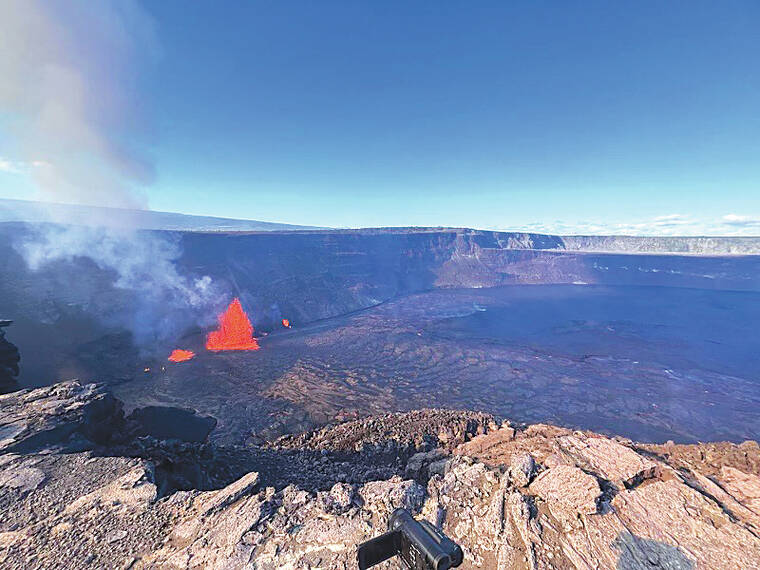Volcano Watch: Kilauea summit erupts again
Kilauea began erupting again on December 23, 2024. This is the eighth eruption of Kilauea, and the sixth within Kaluapele, since 2020. These previous eruptions within Kaluapele lasted from less than one week to more than a year in duration. This history of activity, along with continued summit inflation, suggests that eruptive activity may continue to pause and resume in the coming days or weeks.
The new eruption within Kaluapele (the summit caldera) began at approximately 2:20 a.m. HST on December 23. Lava fountains reached heights of nearly 300 feet (91 meters) and lava flows covered more than 650 acres during two distinct eruptive episodes between December 23 and 25. Both episodes ended abruptly and were followed by the draining of molten lava back into eruptive vents, along with changes in summit tilt from deflation to inflation. The eruption resumed again during the early evening of December 26.
ADVERTISING
This is the third eruption of Kilauea in 2024. It’s noteworthy that these three eruptions occurred in different parts of the volcano. The June 3 eruption occurred southwest of Kaluapele. The September 15-20 eruption occurred on the East Rift Zone. And now this eruption is occurring within Kaluapele. The last time that eruptions occurred in all three of these areas in the same year was 50 years ago!
This diversity of eruptions within a single year is fascinating not only for its historical context but especially for what it can tell us about magma migration and storage within and between different parts of Kilauea. All Kilauea eruptions from 2020 to 2023 occurred within Kaluapele. Things changed in 2024 as magma migrated away from the summit.
Intense sequences of earthquakes, surface deformation and ground cracking occurred in early 2024 as magma migrated toward the Southwest Rift Zone (SWRZ) and approached the surface in the Ka‘u Desert. Activity culminated with the June 3 eruption located 2.5 miles (4 km) southwest of Kaluapele. This emplacement of fresh magma increased the potential for future activity along the SWRZ.
Earthquakes, deformation and ground cracking intensified throughout the summer as magma approached the surface along the upper and middle East Rift Zone (ERZ), damaging Chain of Craters Road. Activity culminated with the September 10-16 eruption at Napau Crater. This emplacement of fresh magma increased the potential for future activity along the ERZ.
Magma continued to accumulate beneath the summit from September through December. Rates of seismicity and ground deformation increased suddenly around 2:00 a.m. on December 23. The current eruption began 20 minutes later. Even though fresh pathways and magma bodies were emplaced along both rift zones in 2024, magma made its way to the surface at Halema‘uma‘u for this eruption.
Spectacular lava fountains and fast-moving lava flows began to diminish around 3:00 p.m. on December 23. The eruption paused. Not only did lava stop erupting, some of it drained back into the vents from which it so recently erupted. “Drainback” events have been observed before and were especially dramatic during the 1959 Kilauea Iki eruption. Lava becomes denser as it degasses during eruption. Denser, degassed lava can then sink back down into inactive vents like water down a drain.
With the surface activity paused, summit deflation changed to inflation as magma reaccumulated beneath the surface. Small lava fountains and flows resumed on the morning of December 24. Fountains increased in vigor around 11:00 a.m., signaling the onset of a second episode.
Episode 2 lasted a little over 24 hours, about twice as long as Episode 1. Lava fountains rapidly died down again just before 11:00 a.m. on December 25. And lava began draining back into the vent at nearly the same time summit tiltmeters began recording a change from deflation to inflation. The pattern was similar but even more abrupt than the onset of the pause on December 23.
Summit inflation continued and the eruption resumed around 5:45 p.m. HST on December 26. The USGS Hawaiian Volcano Observatory (HVO) continues to closely monitor Kilauea and is in contact with Hawaii Volcanoes National Park and the Hawaii County Civil Defense Agency. We at HVO would also like to wish you and your ‘ohana a happy and safe holiday season.
Volcano activity updates
Kilauea is erupting. Its USGS Volcano Alert level is ADVISORY.
A new Kilauea summit began December 23. Since then, intermittent lava eruption has been occurring from vents in the southwest part of the caldera, feeding lava flows on the floor of the caldera. Sulfur dioxide emission rates are elevated in the summit region during eruptive activity. Earthquake rates in the Southwest Rift Zone and upper to middle East Rift Zone remained comparable to the previous week. Ground deformation rates outside of the summit region remained steady.
Mauna Loa is not erupting. Its USGS Volcano Alert Level is at NORMAL.
Two earthquakes were reported felt in the Hawaiian Islands during the past week: a M3.7 earthquake 2 km (1 mi) SE of Hana at 10 km (6 mi) depth on Dec. 19 at 8:44 p.m. HST and a M3.0 earthquake 3 km (1 mi) SSW of Pahala at 34 km (21 mi) depth on Dec. 19 at 9:37 a.m. HST.
HVO continues to closely monitor Kilauea and Mauna Loa.





